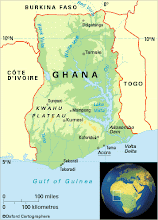On Day 6, Madam Gertrude insisted that we allow her seamstress to make a typically Ghanaian outfit for us. After selecting our preferred styles from numerous designs displayed on posters, measurements were taken. Our host even arranged for the finished articles to be delivered to the VSO office in Accra – photo to follow?
The rest of the day was spent travelling back to the villa in Accra.
On Day 7 our driver, Darlington, had suggested we might like to go to the beach. What he forgot to tell us was we were going via the Shai Hills Resource Reserve. I had forgotten my water and Janet had dressed for the beach!
The Reserve consists of a very striking range of rocky hills surrounded by coastal savannah. We saw many species of birds, including wild Guinea Fowl and Grey Hornbill, as well as bats, baboons and Kob antelopes.
This stick insect caused Janet to panic when it decided to hitch a ride – fortunately it was rescued by the guide before it came to any serious harm.
Our guide also took us to the caves once inhabited by the Dangme Shai people. This tribe was removed from the land to make way for the Reserve.
In discussion we asked our guide, Michael, about his role. He explained that their job was to stop poaching and to show visitors around. We asked how many female guides there were on this Reserves and similar sites around the country. To his knowledge there weren’t any. He thought this was entirely appropriate as he did not feel that women would be able to cope with the physical demands of hiking through the savannah and camping over night.
After a short hike that even we three women were able to manage, we entered one of the caves that were used in the past by the Chief of the Dangme Shai tribe and encountered hundreds of bats. The stench created by these mammals was very strong and the colony took flight as we approached. It was amazing to see how so many of these creatures were able to fly around in such a confined space without colliding with each other.


In the Shai Hills ticket office I came across these exercise books – I don’t think this was the intended use of these resources!
At the end of our tour of Shai Hills Reserve we headed for the beach.
On the way back to Accra we listened to Arsenal defeat Bolton 2-0 on BBC World Service and were greeting by an amazing spectacle over the city’s night sky as literally hundreds of thousands of bats took to the night sky to head off to the surrounding countryside to feed overnight.

























































